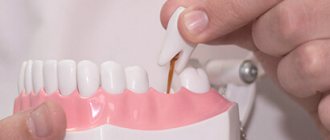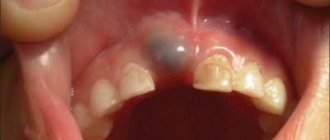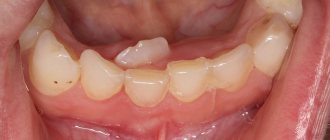There are many misconceptions about whether children's baby teeth hurt. Some parents believe that there is no need to treat these teeth, because they change with age. Others, on the contrary, are convinced that baby teeth require exactly the same amount of care and attention as permanent teeth. Which one is right?
Do baby teeth hurt in children?
First, it’s worth understanding how the dental system develops in children. By the time the baby is born, his mouth is completely missing teeth, which is beneficial for the baby, because his food for the next few months will be breast milk. In addition to the absence of teeth, infants differ from older children in that they have a pronounced sucking reflex. They also have a special type of breathing and a small size of the lower jaw relative to the upper. All these features help infants when feeding on mother's milk.
Infants have no teeth
The process of formation of baby teeth
Starting from the age of 6 months, the child's first teeth erupt. By the age of 2.5 years, the eruption of primary teeth should normally be completed, but all timing is individual. There is a misconception that baby teeth do not have roots. In fact, children's teeth are structured exactly the same as permanent teeth, with the exception of minor differences in structure. The general shape of a baby tooth is similar to that of a permanent tooth: it has a crown, a neck (the transition point between the crown and the root, located at the level of the gums) and a root. Initially, the crown of the tooth erupts into the cavity through the surface of the gum, in this it is helped by the sharp shape of the cusps and cutting edges, as well as intense chewing movements made either when eating or when using a special silicone teether in young children.
Scheme of eruption and loss of baby teeth
Subsequently, over the course of 1.5-3.5 years, the root of each tooth is gradually formed. The period of root formation is followed by a period of rest, when the structure of the tooth remains virtually unchanged. This period lasts on average 3-4 years. Finally, starting from the age of five, one by one, the roots of baby teeth begin to dissolve, giving way to permanent teeth. This process is completely natural and painless if the tooth has not been affected by caries and its complications.
Scheme of eruption of permanent teeth
Prevention
To keep your baby's teeth healthy and strong, watch how and how many times a day he brushes his teeth. By the way, it wouldn’t hurt to teach your baby to rinse his mouth with clean water after every meal, even if he only ate candy. Don’t forget about the diet: the child’s body should receive the maximum amount of vitamins and minerals, which means fish, dairy products, meat, vegetables and fresh herbs should be on the child’s plate every day. But there should be fewer sweets, otherwise caries will become your constant companion.
Features of the structure of milk teeth
What distinguishes temporary teeth from permanent teeth? First of all, the tooth tissues themselves - enamel and dentin - are much less durable. They contain less mineral matter, which means they are more susceptible not only to abrasion, but also to the carious process. The walls of the crowns and roots of primary teeth are thinner, and the so-called “nerve” inside the tooth (its pulp) occupies a much larger volume. For this reason, caries in children occurs at lightning speed and in most cases is accompanied by inflammation of the nearby pulp.
Structure of a human tooth
Insufficiently thorough individual oral hygiene in children necessarily leads to the formation of caries, which often affects more than one surface of the tooth, but surrounds it literally on all sides.
The root of a baby tooth is distinguished by the fact that it has a very wide opening, the so-called root canal. Due to the large width of the canal, inflammation and microbes are quickly transmitted from the dental pulp to the surrounding tissues - periodontium and jawbone. Thus, periodontitis develops, followed by periostitis. In the most unfavorable cases, the germ of the permanent tooth, which is located directly under the root of the milk tooth, is also affected. The infected germ may subsequently grow into a tooth with defective enamel and dentin, or die completely.
Baby tooth
In this case, the permanent tooth will not erupt at all and the patient will be forced to install orthopedic structures to replace the missing tooth or undergo treatment using orthodontic devices, such as braces.
Child with dental structures
The coronal pulp contains sensory nerves, blood vessels and connective tissue. It is located in the so-called pulp chamber, which has a roof, walls and a bottom. The bottom of the pulp chamber is located at the base of the roots, as well as at the place of their divergence in multi-rooted teeth (this place is called a bifurcation). Milk teeth, unlike permanent teeth, have a very thin bottom of the pulp chamber, as well as multiple small tubules connecting the pulp with the periodontium at the bifurcation. With pulpitis and periodontitis, the infection is often transmitted through these tubules, or the thin bottom is destroyed, and in this case, an extensive bone defect occurs in the area of root divergence, which is an indication for tooth extraction.
Stages of caries development up to pulpitis and periodontitis
So, we found out that temporary teeth have a full root, are capable of becoming inflamed and feel pain when the pulp is damaged, and are also especially susceptible to caries due to low mineralization and relatively small wall thickness. Let's look at some of the reasons why baby teeth may hurt in children.
- Which milk teeth fall out in children: diagram
Baby tooth hurts
Caries of baby teeth
Many parents know that of all foods, most babies prefer sweets. They also know that children do not understand the importance of brushing their teeth and are often lazy or skip this procedure altogether. However, not every adult realizes how insidious these bad habits can be. They are the main cause of the formation of caries in children, which is especially destructive, affecting several surfaces of the tooth at once and quickly spreading deep into the tissues.
Initial caries of primary teeth
In young children, caries often develops as a result of excessive bottle feeding. If the child sleeps restlessly, the mother can give him a bottle with a sweet mixture at night. Thus, throughout the night, sweet food will be present in the child’s mouth, which is quickly decomposed by bacteria. The waste product of these bacteria is an acid that destroys tooth tissue and forms carious defects.
With the development of caries, pain occurs when eating cold and sweet foods, such as ice cream or carbonated drinks. Children under 3-4 years old often cannot point to a specific tooth that is causing them discomfort. However, if you notice that when eating, your child cries, touches his lips or teeth, or refuses to eat, you should examine the oral cavity and consult a dentist.
Without proper care, a child’s baby teeth can simply rot at the root at a fairly early age.
Anesthesia in pediatric dentistry
Those manipulations that an adult is able to calmly endure will become the strongest test for a child, both physically and psychologically. Pain management in pediatric dentistry is given a special place, because the psychological trauma from pain received in childhood at a dentist’s appointment will accompany a person throughout his life, and the fear of the dental office will turn into a real phobia. The use of anesthesia by pediatric dentists will remove pain and, accordingly, fear of procedures.
The use of anesthesia in pediatric dentistry has a number of features:
- for the youngest there are restrictions on the use of most products that can be used from 4 years old;
- the doctor must have experience and high qualifications to accurately calculate the active drug;
- children are afraid of treatment of baby teeth , and in general of all dental instruments, especially syringes and injections;
- Quite often, children experience allergic reactions to anesthetic drugs.
Pulpitis of baby teeth
In the absence of timely treatment of caries, inflammation of the pulp or pulpitis develops. In this case, the microbes that initially affected the enamel and dentin reach the nerve, causing intense, long-lasting pain. Often the pain occurs on its own, the child stops sleeping peacefully, cries and complains about his teeth at night. The child’s face in the cheek area may become swollen, and general health may deteriorate.
Structure of a pulpit tooth
In other cases, pulpitis occurs for a long time without pronounced symptoms, but this should not reassure parents, because the affected tooth still requires treatment. You should not wait for the process to worsen; it is preferable to treat a baby tooth when the child has virtually no complaints. This way, the treatment procedure will be calmer, without additional stress for the little patient and his parents, and the doctor won’t have to spend a long time persuading the baby to open his mouth.
Pulpitis of baby teeth
Anesthesia in pediatric dentistry, types
1. Application of local anesthesia
Most often used. It is carried out in 2 stages - “freezing” with a gel or spray, after which the drug is injected. Typically, children of any age tolerate this type of anesthesia well. Sensitivity is not completely lost; minimum contraindications.
2. Use of sedation
A sedative is inhaled. The child relaxes, but remains conscious. This is not anesthesia in its “pure form”; there is no strong analgesic effect. It is often used with an injection of an anesthetic drug.
3. Use of general anesthesia
It is used in extreme cases, because the risk of complications after dental treatment under general anesthesia exceeds that with local anesthesia. The pediatric dentist must have good reasons for using general anesthesia, because this causes profound depression of the nervous system, which can be followed by complications. The primary thing is to correctly calculate the dosage and take into account the individual characteristics of the small patient.
The anesthetic drug is given by inhalation: by inhaling the vapor of the drug, the child falls asleep. The doctor gets the opportunity to quickly and calmly treat the tooth, and the child will not feel pain or get stressed.
Periodontitis of baby teeth
After prolonged inflammation of the pulp and without treatment, the root/coronal pulp dies. In its place, in the pulp chamber and canals of the tooth, necrotic destroyed tissue remains, abundantly contaminated with pathogenic microorganisms. From the root canal of the tooth, microbes enter the periodontal ligament of the tooth, and from it into the bone, causing destruction and inflammation. A granuloma forms around the root, and fistulas form on the gums in the area of the affected tooth, from which the pus accumulated in the bone is released.
Signs of periodontitis
The tooth changes color from milky white to dark gray. The child stops complaining of pain from eating sweet, cold and hot foods, since with periodontitis the pulp loses sensitivity due to its complete death. Pain occurs when chewing and biting food, as well as when pressing and tapping on the tooth. When the process worsens, the general condition sharply worsens, swelling occurs, and the temperature rises.
The roots of baby teeth affected by periodontitis dissolve quite quickly. Such resorption is not physiological, it occurs untimely and is a consequence of inflammation, and also very often affects the germ of a permanent tooth. Most often, baby teeth with periodontitis must be removed.
Periodontitis in children on the upper jaw
In order to preserve not only milk, but also permanent teeth in a child, it is necessary to promptly detect and treat caries and its complications at all stages, and in some cases, remove teeth that cannot be treated.
Periodontitis of baby teeth
Alternative to general anesthesia
The safest alternative is sedation. Through a mask, the patient inhales a mixture of oxygen and nitrous oxide. A slight relaxation and drowsiness appears, and the feeling of fear disappears. At the same time, the child is conscious and able to do what the doctor says.
Sedation cannot be considered anesthesia in the full sense, but it still provides an analgesic effect, and in combination with an injection of an anesthetic it provides a good result. The gas composition is supplied through a device that controls the dose of the mixture, the time of sedation, allowing you to smoothly enter and exit “half-sleep”. After stopping the supply of the mixture, the effect lasts about 10 minutes.
Gingivitis in children
Another common cause of oral pain in children is gum disease, or gingivitis. The child cannot always determine what exactly caused the pain - the tooth or the gums. Parents should periodically independently examine the child's oral cavity to assess not only the presence of visible cavities, but also the state of the child's oral hygiene. It is the accumulation of a large amount of soft and hard plaque that causes inflammation of the gums, due to the proliferation of pathogenic bacteria in this plaque.
- At what age do baby teeth fall out?
Gingivitis in children
When examining a child’s oral cavity, you can detect gum redness, swelling, and bleeding. All these are signs of gingivitis, which means you need to consult a dentist to make an accurate diagnosis, identify the cause of the disease and prescribe treatment.
Gingivitis can be caused not only by poor oral hygiene, but also by diseases of the child’s internal organs, vitamin deficiencies and endocrine disorders.
Gingivitis
In addition to treatment, it is necessary to adjust the child’s teeth brushing technique, in which both the dentist and parents should help him. You should also discipline your child and motivate him to brush his teeth regularly, not to be lazy and not to skip brushing his teeth.
Table. Features of different forms of gingivitis.
| Form of gingivitis | Child's age | Appearance | Causes |
| Acute traumatic | Any | Red, swollen, painful gums in one limited area | Accidental mechanical trauma to the gums by foreign objects or hard food |
| Chronic catarrhal | Mainly after teething | Red, swollen, painful, and bleeding gums over the entire jaw or both jaws | Poor and irregular oral hygiene, chronic diseases, weak child immunity |
| Chronic hypertrophic | Teenage years | Enlarged, swollen gums, bleeding, discoloration of gums | Incorrect position of teeth, hormonal changes in the body, endocrine disorders |
| Chronic desquamative | Mainly after 6 years, adolescence | Bright red, smoothed gums with signs of atrophy and multiple erosions | Concomitant skin diseases, allergies to personal hygiene products |
First examination of a newborn
Immediately after birth, the baby is examined by specialists, including a dentist. This is important because an assessment of the general condition and reflexes is necessary, but the primary question is the size of the frenulum of the tongue. With a shortened frenulum, the child will not be able to grasp the nipple and suck normally. External examination and assessment of tongue movement does not always reveal abnormalities. This may appear in the next 5-15 days:
- smacking sounds appear during feeding;
- a long feeding process: the baby sucks, then pauses for a while and starts sucking again;
- Mom develops cracks and pain in her nipples;
- the child is capricious at the breast;
- is gaining weight poorly.
If such symptoms are noticed, you should make an appointment with a doctor so that he can examine the baby, determine the size of the frenulum and make the appropriate prescriptions.
What should you do if your child has toothache?
If acute pain appears, it is necessary to examine the oral cavity and try to find out the approximate cause of the appearance and nature of the pain, and then give the child an anesthetic that has been approved by a pediatrician specifically for your baby. Under no circumstances should you resort to using remedies recommended by strangers, as each medicine is tolerated differently by individuals and can cause serious complications, including death. Next, you should immediately consult a dentist.
You should not delay treatment, as inflammatory and purulent processes in children develop very quickly, spread to nearby tissues and cause extremely negative consequences.
If a child experiences acute toothache, you should consult a dentist.
If the nature of the pain is unexpressed, periodic, you should schedule a visit to the dentist in the near future as planned. Treatment outside of an exacerbation is better and more effective, so you should not delay seeing a doctor. The health of baby teeth guarantees not only a quiet life for the baby, but also the correct and complete eruption of healthy permanent teeth. After tooth extraction, how long after you can eat, read on our website
Should I go to the dentist if my teeth are fine?
Regular preventative dental examinations are needed not only for adults, but also for children. Moreover, in childhood they are required even more often. If adults are advised to visit a doctor every six months, then children, due to the characteristics of tooth enamel and potential risks, should visit a doctor every three months.
In addition, parents should visit an orthodontist when their baby’s teeth begin to change. The specialist will conduct an examination,, if necessary, prescribe an x-ray of the oral cavity and recommend treatment that will help the permanent teeth grow evenly and in their places. This means your child’s smile will be beautiful and healthy.











